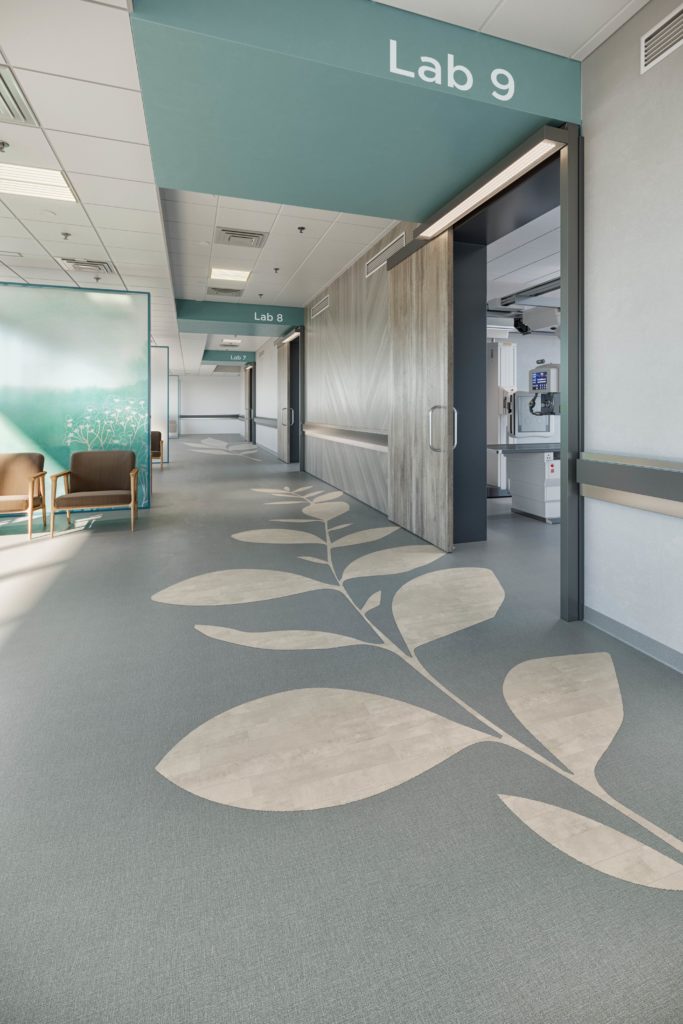Product trends to focus on human and ecological health
In the coming year, flooring product trends within the commercial market will reflect several broader design trends that focus on human and ecological health and shifting generational needs.
As commercial interior design continues to be driven by a growing focus on health in the U.S., designers noted a focus on biophilic design, a concept intended to support human wellbeing in the built environment. This design concept has prompted vendors to focus on natural materials or to emulate nature within a specific product line. In addition, a growing millennial workforce may bring with it a mounting need for modularity and an ever-growing focus on “cause-minded” building supplies. As such, flooring vendors are on task to develop flexible designs and sustainability-first product lines.
Biophilia
Biophilic design within the commercial space has been slowly growing in popularity as the proof of its benefits to human health has begun to emerge. As such, vendors noted its ongoing impact on the interior design and product trends of 2019.
“The idea of being one with nature is not a new idea, but recognizing and quantifying benefits associated with being connected to nature is a new and evolving concept, and one which plays out importantly in flooring,” said Amy Costello, sustainability manager, Armstrong Flooring. “The design trends we see revolve around the natural elements of design that contribute to the well-being and productivity of the occupants in a space, whether it be healthcare, assisted living, education or office.”
In terms of healthcare specific design, Julie Elliot, interior designer, Jensen + Partners, said, “What we are being asked to do as interior designers is not always to have healthcare needs met from a clinical perspective (infection prevention, highly durable products, etc.), but it really needs to have more of a hospitality feel. That is driving a lot of the newer products you’re seeing.”
She added that elements such as natural finishes, natural daylight and access to the outdoors with healing gardens is a huge driver for biophilia-inspired projects. “There’s a big push to almost have some of the amenities that you might find at a spa,” she said. “That is a huge change.”
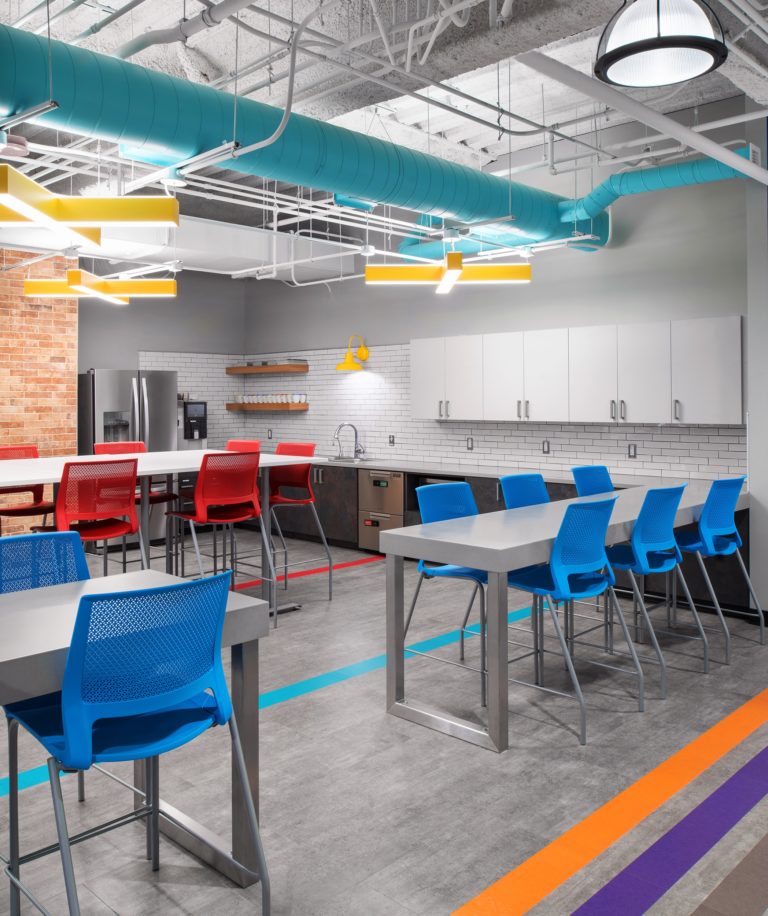
Armstrong Commercial
Natural Creations LVT from Armstrong offers an array of modular shapes and sizes inspired by the natural beauty of wood as well as the colors and organic variations of stone and the distinctive woven appearance of textiles. The collection is available in several colorways.
Flooring derived from natural materials such as wood, linoleum or bio-based flooring fit these needs, Costello noted, and innovative products such as luxury vinyl tile or sheet vinyl inspired by natural shapes, patterns and colors also contribute to this concept.
When it comes to office spaces, Shannon Cochran, Patcraft’s vice president of creative and design, also noted a shift toward a holistic approach to employee satisfaction. “We see more and more spaces that are designed with empathy and consideration for work-life balance,” she said. “Often these spaces are inspired and influenced by nature, using texture and patterns to evoke a sense of calm and well-being within the workplace.”
Color, too, plays an important role in the attempt to bring the outside in. Designers noted the introduction of a variety of colorways has the potential to make indoor spaces feel more natural. “There used to be a tendency towards the cool colors — the blues, greens and the bluer grays — and that lent itself to an institutional feel,” said Sandra Leibowitz, managing principal, Sustainable Design Consulting. “People respond differently to color but bringing in more of a full spectrum of color into the flooring, walls, curtains and other fabrics and the furniture is definitely a trend.”
She has witnessed a move toward warmer colors. “The reds and the oranges and brown from the wood – I think that is very positive in terms of making the environment feel more normal,” she said. “What other environment is a minty blue green all the time?”
Modularity
The role of generations in the product trends of the day is not one easily defined. However, designers and vendors alike have noted a need to listen to today’s consumer, be they millennial, Gen X or baby boomer, when designing for commercial spaces. No doubt, millennials in particular have had a vast influence on societal norms — an impact that has trickled all the way down to product specifications and even product development within the flooring industry.
The focus on health and wellness within all aspects of commercial building — healthcare, education, office, etc. — have no doubt been championed by the current needs of the consumer. As such, the focus is now on universal multi-generation design, said Cynthia Hubbell, vice president of healthcare & senior liv- ing, Mohawk Group. “It’s about creating invigorating spaces that can serve baby boomers, gen-x’ers and millennials,” she said. “This includes incorporating facets of design that serve those who are differently abled. It’s no longer about creating ‘nice’ environments; it’s now about creating great environments that are completely bespoke – both to an individual and to societal groups as a whole.”
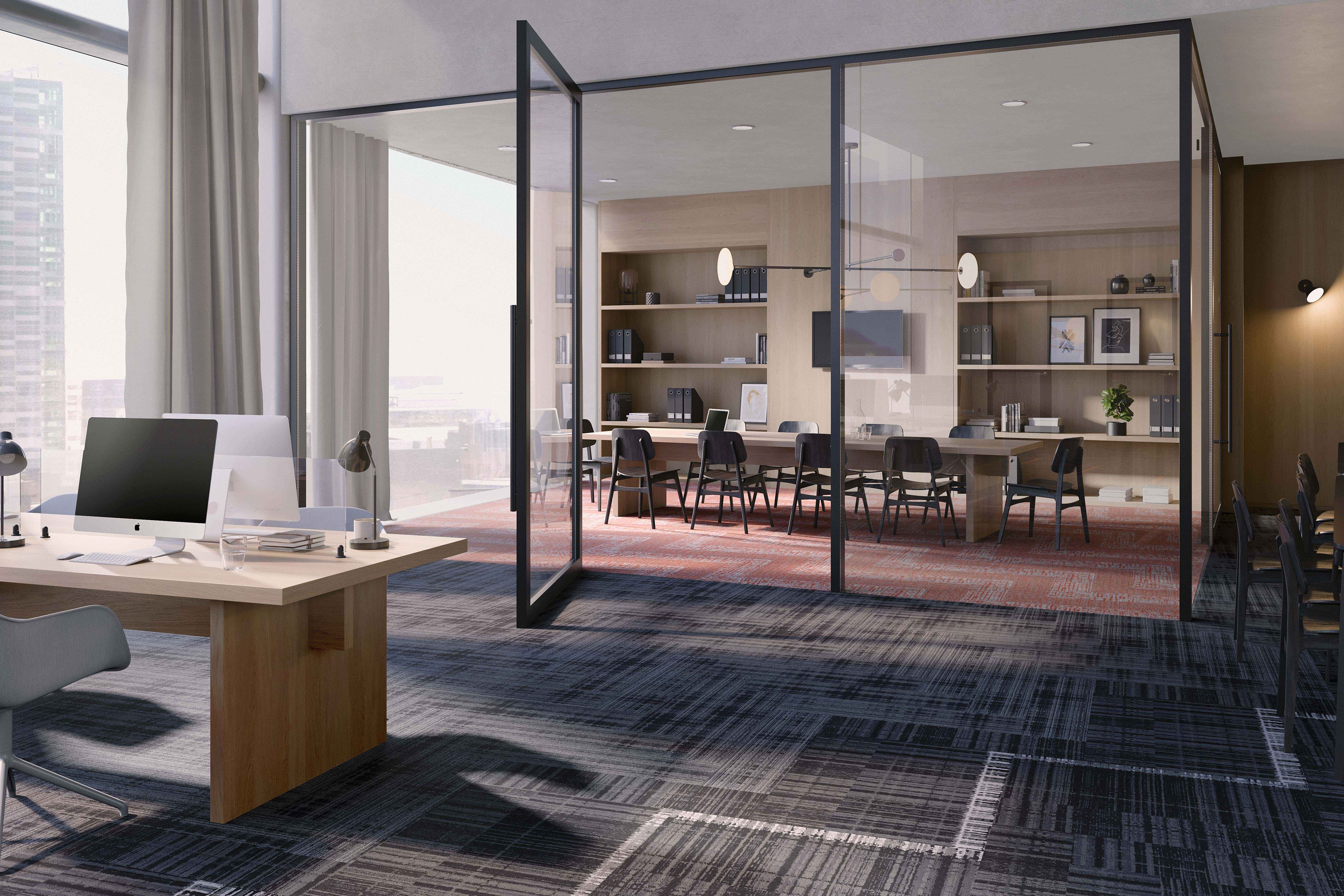
Tarkett
Tarkett’s Tailored Twist modular carpet tile collection features four unique patterns: Tailored, Tailored bloom, Tailored plaid and Tailored madras. Any of the patterns can be ordered individually or combined to create a custom feel.
The idea of modularity within commercial spaces is one way in which the evolution of generational needs has impacted product trends. Modularity is a trend that is beginning to take shape within the commercial realm — and one that some flooring vendors said will have a large impact on design in the coming year.
“As organizations increasingly hire contractors and free- lancers and allow employees to telecommute and job-share, their need for flexible spaces that can shift throughout the day to meet ever-changing needs will be paramount,” said Traci Kloos, director of design marketing, Tarkett. “Modularity is having a tremendous influence on our product development in 2019. We’re looking at how different surfaces can work together and pairing these recommendations for designers to assist in their specifications. We’re also looking at unique, less permanent installation methods that will help building owners adjust as their workforce changes.”
CONSCIOUS DESIGN
Another trend that will continue to drive the industry forward is the idea of a purpose-driven culture, according to Patcraft’s Cochran. “Companies are doing business with a conscience as they build their internal cultures,” she said. “It’s not only important to think about how the design of the space affects the user, but also how the materials used impact the environment they occupy. Through supply chain management, we see a focus on safe, sustainable, circular materials and recyclable and renew- able products.”
As such, flooring vendors across the board are putting a heavy focus on the eco-conscious and sustainable aspects of their flooring products. One of Patcraft’s newest products, named Render and launched at NeoCon this year, for example, is PET (non-vinyl) resilient tile made from compressed polyester fiber and approximately 40% recycled PET fiber.
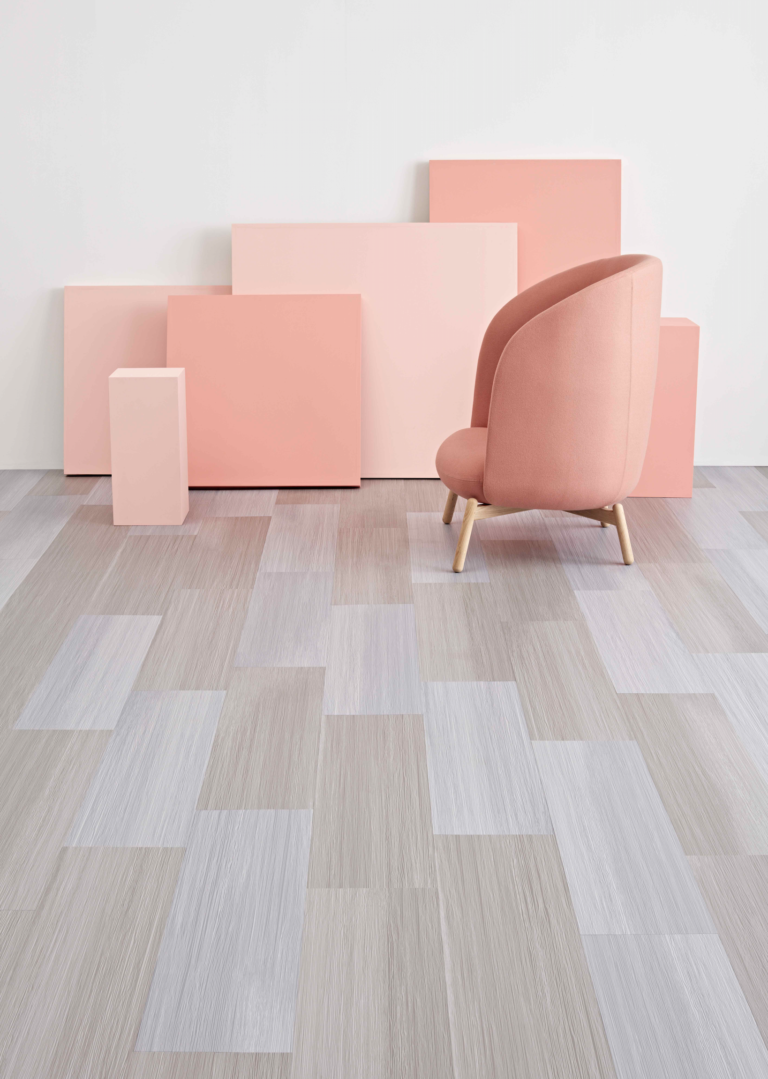
Patcraft
Patcraft’s Render is a PET (non-vinyl) resilient tile made from compressed polyester fiber and approximately 40% recycled PET fiber. A large portion of the coreboard is comprised of waste polyester material that is reclaimed primarily from used soda bottles and industrial trim waste.
“A large portion of the coreboard is comprised of waste poly- ester material that is reclaimed primarily from used soda bottles and industrial trim waste,” Cochran said. “Render is also backed by Patcraft’s environmental guarantee specifying that the company will reclaim and recycle the product at the end of its useful life.”
Valerie Molinski, environmental stewardship manager, Tarkett, said the company has long considered the full lifecycle of its products, continually evolving the materials used at every phase, from installation to maintenance. “Increased modularity in design may lead to more frequent updates for spaces, so it’s critical to consider a product’s end of life and develop flooring products with materials that can be 100% recycled into new flooring,” she said.
For Mohawk, Hubbell said the company has a variety of Living Product Challenge Petal certified flooring products that are not only created to meet the unique challenges of commercial spaces but are designed to give more back to the environment and its inhabitants than they take in their entire life cycle. “Living Products like Pivot Point, one of our newest enhanced resilient tile collections, are designed to inspire and help con- tribute to healthy spaces,” she said. “We are proud to be able to offer sustainably-sourced products that meet not only our mission as a flooring manufacturer but as a provider of solutions that help encourage optimum health and wellness.”
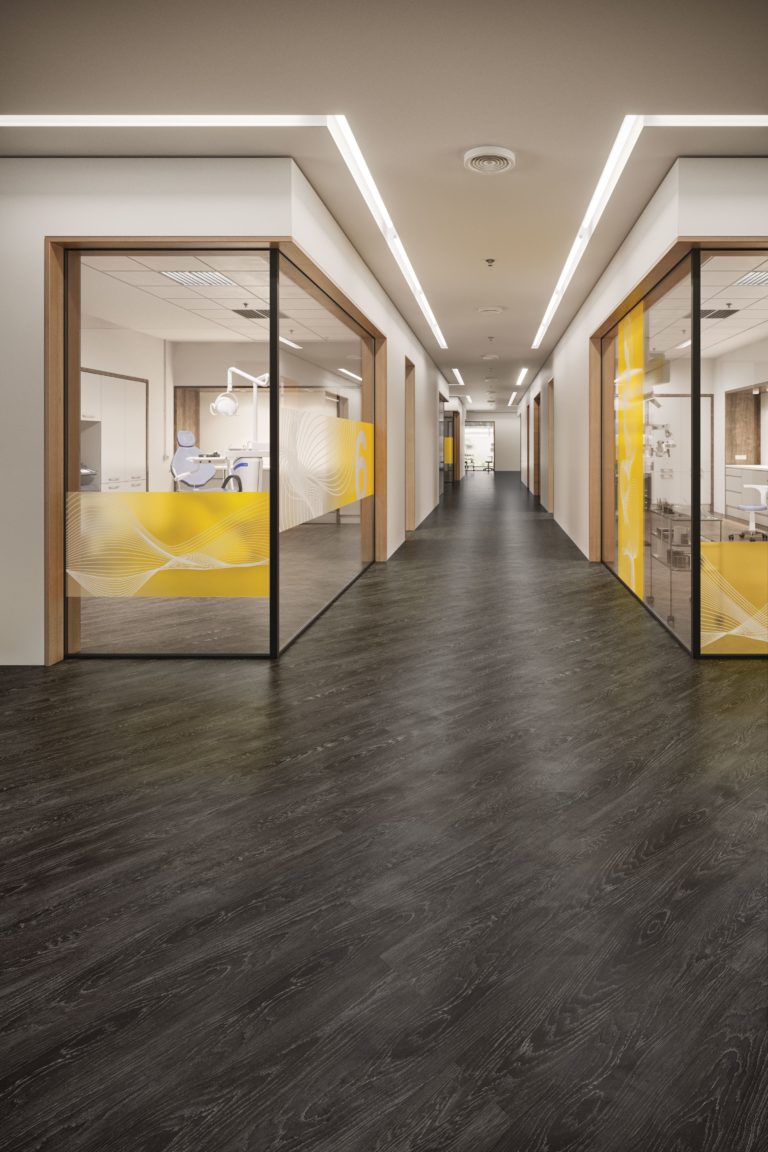
Mohawk Group
Mohawk’s Pivot Point Red List-free enhanced resilient tile holds Living Product Challenge Petal certification and is manufactured using alternative chemistry. In addition to its petal certification, pivot point is also FloorScore certified.
Considering the whole building and the impact flooring may have on sustainability, including lifecycle, maintenance requirements, overall cost and occupant well-being is key for Armstrong, according to Costello. For example, a low-maintenance product can save over the long run, even if it has a higher initial cost; a more durable product will have a longer lifespan, delaying the replacement and disposal costs; timeless design choices can ensure that the product won’t be replaced as soon as it goes out of style; design choices that enhance occupant comfort and well-being will have a positive impact on sales, productivity and employee retention; and design choices can impact other factors, such as lighting and HVAC energy use, and can reduce building operating costs, she said.
One such product developed with sustainability in mind is the company’s bio-based tile (BBT). “To help customers cre- ate the most sustainable environments that are both beautiful and durable, the innovative bio-flooring lines of Striations BBT and Migrations BBT continue to reinforce Armstrong Flooring as a leader in advancing sustainability,” said April Hoelscher, senior marketing manager, Armstrong commercial channel.
